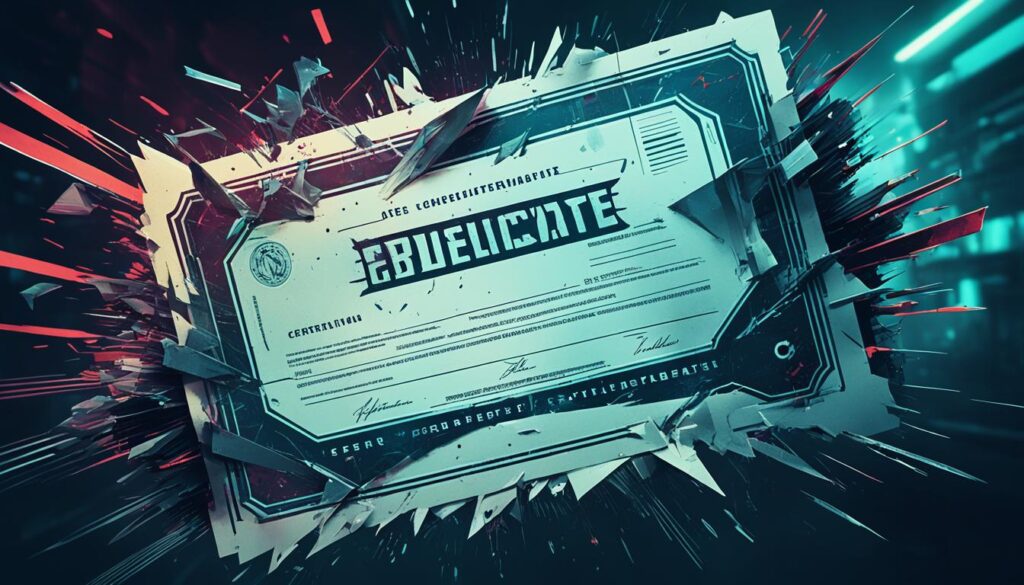Did you know that a single instance of unauthorized access to a code signing certificate can compromise the security of software distributed to millions of users? The consequences of a security breach amplified by a trusted digital signature can be severe, prompting the critical best practice of revoking code signing certificates. When the sanctity of a code signing certificate is put in jeopardy—whether through unauthorized disclosure, loss, or theft—proactive code signing certificate revocation becomes an essential guardrail in maintaining trust and integrity in the digital world.
Key Takeaways:
- Revoking a code signing certificate is an essential security measure to protect software integrity.
- Once a certificate is revoked, any code signed with it may trigger trust warnings to the end user.
- Code must be re-signed with a valid certificate to maintain trust and avoid potential software disruptions.
- A lost hardware token, compromised private key, or retirement of a certificate are key reasons for revocation.
- The revocation process is an irreversible action that safeguards the reputation of the software publisher.
Understanding Code Signing Certificate Revocation
Revoking a code signing certificate is a deliberate measure taken to protect software integrity and the trust of users. When a certificate is deemed unsafe or compromised, the revocation ensures that no malicious party can exploit the digital signature. Below, we explore the inherent aspects of the revocation process, emphasizing its importance in the secure management of software distribution.
The Imperative of Revocation: Security and Trust
The revocation of SSL certificates is not a step to be taken lightly. When the safety of a private key cannot be guaranteed or when intentional discontinuation occurs, the revocation process must begin immediately. It’s the digital equivalent of a product recall, ensuring no further use of the invalidated credential, thereby upholding security protocols and maintaining the trust of software users.
Certificate Revocation List (CRL): How It Works
Upon revoking a code signing certificate, the issuing certificate revocation authority—such as DigiCert—adds the certificate’s serial number to the Certificate Revocation List. This list is an essential component of the revocation ecosystem, acting as a definitive reference for clients to verify the authenticity and safety of certificates in use.
| CRL Attribute | Description | Impact on Trust |
|---|---|---|
| Serial Number | Unique identifier for the revoked certificate | Ensures specific identification of a compromised certificate |
| Revocation Date | The exact date and time the certificate was revoked | Confirms the starting point of untrustworthiness |
| Reason | The cause leading up to the revocation action | Provides context for the revocation, enhancing the transparency of the decision |
| Issuing Authority | The entity responsible for managing the revocation process | Stands as a testament to the authoritative decision of revocation |
The Validation Process After Revocation
Once a certificate finds its place on the CRL, it signals a clear message that it should not be trusted. The certificate revocation process is critical for ensuring that any signed code or communication previously considered secure is now flagged as suspect. During validation, client systems reference the CRL to prevent the execution or acceptance of code using revoked credentials, thus closing the loop on potential security breaches.
Revoking Code Signing Certificates: When and Why?
In the domain of software security, the integrity of digital signatures is paramount. Understanding how to revoke a code signing certificate plays a critical role in maintaining that integrity. Code signing certificates serve as a digital seal of approval, ensuring that a piece of software or an update is genuine and has not been tampered with. However, there are instances when revocation is not just necessary, but imperative.
The decision to revoke a digital signature certificate is typically driven by the need to protect end users and the organization’s reputation from potentially hazardous security breaches. Revocation becomes essential under several circumstances, most notably when the private signing key associated with the certificate is compromised. A breach of this nature could allow malefactors to distribute malicious software under the guise of the original publisher’s name.
- A significant reason for revocation is the loss or theft of the hardware token that stores the private key.
- Revocation is also warranted if there are changes in project requirements indicating that the code signing certificate is no longer necessary.
- Moreover, in cases where the certificate was mistakenly issued or obtained fraudulently, immediate action to revoke is critical.
The repercussions of not revoking a compromised certificate can be substantial, potentially leading to the installation of damaging software on user systems, erosion of trust in the publisher’s software, legal liabilities, and more. Therefore, revocation is not only a technical process but also a means to uphold trust and confidence among users.
Ensuring the security and authenticity of the software we interact with daily is a collaborative venture between publishers and users. By revoking certificates when necessary, publishers take a proactive approach to cybersecurity, demonstrating responsibility and establishing trustworthiness.

While the strategy on how to revoke a code signing certificate may vary slightly from one Certificate Authority (CA) to another, the overall goal remains consistent: to prevent misuse and maintain a secure software ecosystem. Whether you are a developer, a software publisher, or an IT administrator, understanding when and why to revoke a certificate is crucial.
Take heed of the steps required to efficiently manage and, when necessary, revoke digital signature certificates, thereby mitigating risks and cementing a secure foundation for software distribution. Focus on maintaining round-the-clock vigilance over your certificates’ status and take decisive action when security is jeopardized.
How to Revoke Code Signing Certificate: A Step-by-Step Process
Revoking a code signing certificate is a critical procedure for ensuring the security of software distribution. When a certificate may have been compromised, or its association with the software needs to be undone, understanding how to revoke code signing certificate is essential. Let’s delve into the process that maintains the integrity of digital signatures and contributes to effective code signing certificate validation.

Submission of Revocation Request
To start the revocation process, the certificate holder or a recognized authority must submit a revocation request. This initial step is typically facilitated through an online interface provided by the certificate authority. Documentation or grounds for revocation, such as a compromised private key, should be prepared and duly submitted with the request. It is important to be precise and clear when detailing the reasons why the revoke digital signature certificate action is warranted.
Administrative Approval and Execution
Once the request is submitted, an administrator at the certificate authority, like DigiCert, must approve it. This approval is needed to maintain operational integrity and prevent unwarranted certificate revocations. The table below outlines the key steps that follow once administrative approval has been secured:
| Step | Action | Outcome |
|---|---|---|
| 1 | Administrator Review | Verification of revocation request against security protocols of the certificate authority |
| 2 | Approval | Revocation request is acknowledged and authorized for execution |
| 3 | Revocation Execution | The certificate is officially revoked, and its status is updated accordingly |
| 4 | Record Update | Revocation details are added to the Certificate Revocation List (CRL) for public knowledge |
| 5 | Notification | The entity that requested the revocation is notified of successful completion |
Remember, once a code signing certificate has been revoked, the action is irreversible. Thus, entities must be ready to reissue and resign their software with a new certificate. This cycle of maintain, revoke, and reissue is vital for robust code signing certificate validation, protecting software publishers and users alike.
The Impact of Revocation on Signed Code
Understanding the code signing certificate revocation process is essential for developers and organizations that maintain the security of their software products. Revocation leads to a cascade of effects across any system trusting the compromised certificate. Once a code signing certificate is revoked, there’s an immediate need for action to ensure a continued secure user experience.
Revoking an SSL certificate similarly affects website trust. For users, this means their browsers may warn them away from sites with revoked certificates. Such an intimation often deters users and erodes confidence in the brand. By revoking SSL certificates, companies signal to web users that they prioritize security, even though there may be short-term inconvenience.
Upon revocation of a code signing certificate, software previously deemed safe by the users’ operating systems suddenly becomes unverified. This can lead to warning prompts, cessation of software execution, and loss of user trust.
These warning prompts, although disruptful, serve as an essential line of defense against potential vulnerabilities that may have been introduced due to compromised certificates. Because the revoked certificates invalidate all previously signed code, developers are advised to:
- Resign their code with a new, trusted certificate promptly.
- Communicate with users about the reason for revoked certificates and the steps taken to resolve the issue.
- Ensure all software distribution points have refreshed their trust stores to recognize the new certificates.
Through proactive management and communication, developers can minimize the impact of certificates being revoked, maintaining the diligence necessary in a landscape where cybersecurity is paramount.

It’s not just active software that feels the effects of revocation. Legacy systems that may still operate on older versions of software require particular attention to avoid unintentionally sidelining what may be critical operational tools for certain users.
Ultimately, the revocation of code signing certificates is a powerful mechanism that underscores the importance of diligence and proactive management in digital security but requires careful handling to balance security and user experience. It’s a reminder that in the digital realm, trust is always on a knife-edge and vigilance is the guardian of integrity.
Best Practices for Managing Code Signing Certificates
Securing and managing code signing certificates effectively is critical to maintain the integrity of your software and to protect it from malicious tampering. Establishing a robust protocol for handling these certificates helps prevent unauthorized access and ensures that your software preserves its reputation for safety and reliability. Here are key strategies to foster stringent security practices:
Key Security: Storing and Protecting Your Private Keys
To secure the cornerstone of code signing certificate validation, it is essential to enforce rigorous control over private keys. Experts recommend the use of hardware security modules (HSMs) that offer a fortified environment resistant to potential breaches. It is also advisable to perform regular audits and restrict access to the keys strictly to personnel who require it to perform their job functions. Ensuring the private keys are well-guarded helps in preventing the need for the certificate revocation process.
Access and Authentication Protocols
Well-defined access and authentication protocols are non-negotiable in managing code signing activities effectively. Implementing multi-factor authentication (MFA) and requiring stringent verification ensure that only authenticated users can sign code with your organization’s certificates. In case of a security lapse leading to potential risk or compromise, having proper protocols in place allows for swift action, precisely identifying and revoking the implicated certificates.
- Minimize access to private keys to reduce risks
- Use cryptographic hardware products to safeguard keys
- Authenticate and virus-scan your code before signing to avoid malware propagation
- Distribute risk by avoiding the overuse of a single key for code signing
- Log all code-signing activities for an accurate audit trail
By incorporating these best practices for code signing certificates into your security framework, you can ensure a resilient line of defense against cyber threats. Remember, proactive measures are vital; it’s always preferable to avoid certificate revocation by safeguarding your key than to deal with the fallout once trust is compromised.

Code Signing Certificate Validation and Compliance Standards
The digital landscape demands robust security measures and adhering to comprehensive compliance standards is crucial for authentication and trust. In the realm of software development, code signing certificate validation is a non-negotiable best practice that aligns with stringent industry standards and ensures the integrity of distributed code.

Organizations must implement strategies that exceed the bare minimum, fostering a culture of security that permeates every phase of the development lifecycle. These strategies are fundamental to not only meeting but surpassing obligations towards customers and regulatory bodies.
Industry Cryptographic Standards and CA/B Forum Guidelines
Ensuring cryptographic security is a meticulous process that starts at the very initiation of a code signing certificate’s lifecycle. Employing protocols set by the CA/Browser Forum, developers and organizations must follow best practices for code signing certificates, focusing on the safeguarding of private keys. To fortify the trust in public transactions, these keys are typically stored in certified Hardware Security Modules (HSM) or under sophisticated encryption controls.
Maintenance of these high standards is verified through rigorous certificate revocation process to promptly invalidate credentials that no longer comply with security protocols or have been compromised. Here’s how compliance standards typically break down:
| Standard/Requirement | Description | Implementation |
|---|---|---|
| CA/B Forum Baseline Requirements | Minimum standards for the issuance and management of public trust certificates. | Mandatory use of HSMs for key storage, MFA for system access, and regular audit trails. |
| Extended Validation (EV) | High-assurance certificates that require thorough vetting of the requesting entity. | Strict organizational authentication and physical security measures in place. |
| HSM Compliance | Usage of secure devices for key generation and storage to prevent unauthorized access. | Deployment of HSMs compliant with industry standards like FIPS 140-2. |
Automated Code Signing in Software Development Life Cycle (SDLC)
Automating the code signing process within the SDLC aligns with best practices for code signing certificates, and serves as a testament to an organization’s commitment to security at every stage of software development. By integrating automated workflows, companies enforce consistent security policies, reduce human error, and ensure that all signed code is subject to the same rigorous standards for validation and compliance.
Aside from increasing efficiency, automation significantly enhances the reliability of the certificate revocation process, making it faster and more effective in securing the software supply chain. By establishing clear criteria for signing and auditing, automated systems maintain the sanctity of digital signatures, and provenably buttress an organization’s dedication to trust and security.
With steadfast code signing certificate validation and compliance to industry standards, organizations erect a formidable barrier against threats and position themselves as trusted purveyors in the digital realm.
Preventative Measures: Minimizing the Risks of Certificate Compromise
The digital landscape necessitates stringent measures to guard against the unauthorized exploitation of code signing credentials. To reduce the odds of having to revoke digital signature certificates, a robust strategy to preclude compromise is indispensable. Herein lies a synopsis of such preventative protocols designed to preserve the sanctity of such certificates.
Key Storage Security: Ensuring the security of cryptographic keys is a fundamental aspect of the overarching protective framework. It is crucial to employ hardware that is specifically fashioned for cryptographic purposes, such as Hardware Security Modules (HSMs), to store private keys. These instruments offer superior protection against breaches, thereby significantly bolstering the security landscape surrounding sensitive key material.
Access Control Enforcement: Another major facet of securing digital signature certificates involves stringent access control measures. Access to key management areas should be encompassed by multi-layered authentication mechanisms that may include, but are not limited to, biometric scanners, smart cards, and PINs. This not only deters unauthorized access but also deconstructs the potential for a single point of failure.
Regular Audits: Conducting habitual audits of code signing activities is an effective approach for early detection of discrepancies that could manifest as security risks. Such audits should be thorough, covering all aspects of the signing process, from initiation to completion, thereby ensuring that any anomaly is promptly identified and addressed.
- Employ cryptographic hardware to deter key compromise
- Implement rigorous layers of access control
- Conduct comprehensive periodic audits
- Practice separation of duties amongst team members
- Apply multi-factor authentication (MFA) for all sensitive operations
The aim is to preempt situations where revoking code signing certificates becomes a necessity due to security breaches. By adopting a preventive stance replete with the aforementioned practices, organizations can steadfastly erect a bulwark against the unauthorized exploitation of their code signing credentials.
Considerations for Timestamping When Signing Code
When developers and organizations consider the security lifecycle of their software, an integral part of the conversation involves the concept of timestamping during the code signing process. Timestamping plays a critical role, especially in the context of revoking code signing certificates. It is a practice designed to extend the verification of code integrity well beyond the natural expiration date of a code signing certificate or its unexpected revocation.
Software that has been signed with a timestamp continues to retain its validity even if the code signing certificate is revoked, which is an essential part of the certificate revocation process. In doing so, it ensures continuity of trust and avoids potential operational disruptions that could be detrimental to end users and developers alike. In view of the importance of the timestamping feature for signed code, it is necessary to understand the dynamics of this process.
Below is an overview of the valid period extensions that timestamping can offer, safeguarding the commitment to code security:
| Certificate Status | Without Timestamp | With Timestamp |
|---|---|---|
| Before Expiry | Code remains valid | Code remains valid |
| Post Expiry | Code is not trusted | Code remains valid up to 135 months |
| After Revocation | Code is not trusted | Code remains valid if timestamped before revocation |
It’s evident that timestamping, when implemented correctly, becomes a fortress of trust for software longevity. Proper timestamping ensures that even in the face of revoking code signing certificates, the integrity of the software remains unaffected for the users. Developers should therefore make it a standard practice to always include a reliable timestamp when signing their code.
Timestamping mitigates the risks associated with certificate expiration and revocation, reinforcing software integrity.
- Fortifies trust post-certificate revocation
- Extends verification of the code’s integrity
- Supports continuity for end users and developers
Deploying timestamping is therefore not only a security measure; it is also fundamentally an investment in the software’s reputation and the trust of its user base. When considering the broader certificate revocation process, timestamping stands out as a strategic tool to ensure the long-term reliability of software circulating in the digital space.
Conclusion
Secure software distribution hinges upon the vigilant management of code signing certificates. The act of revoking code signing certificates plays a pivotal role in this process by preserving digital trust and preventing security lapses that might otherwise compromise software integrity. It’s not merely about reacting to threats; it’s also about upholding responsibility towards users and maintaining the sterling reputation of software publishers.
With evolving cyber threats, the significance of a robust certificate revocation process cannot be overstated. Inclusion in a certificate revocation list is a testament to a diligent and responsive security posture. Organizations that prioritize timely revocation—and are swift to revoke SSL certificates when necessary—underscore their commitment to security and trustworthiness in the digital realm.
The necessity for stringent certificate management practices, from the onset of a certificate’s lifecycle to its potential revocation, is crystal clear. Adherence to these protocols not only fortifies security measures but also forms the bedrock of a trustworthy digital infrastructure for software products. As such, the thorough understanding and execution of code signing certificate revocation are indispensable links in the chain of software security.
FAQ
What is code signing certificate revocation and why is it important?
Code signing certificate revocation is the process of invalidating a code signing certificate so that it can no longer be used to sign software. It’s a crucial security measure to maintain trust, as it ensures that any software signed with a revoked certificate is flagged as untrusted. This is important if the certificate is compromised, or no longer needed.
How does the Certificate Revocation List (CRL) work?
The Certificate Revocation List is a publicly available list that contains the serial numbers of revoked certificates. Client software checks this list to verify whether a certificate has been revoked or is still valid. It ensures users do not trust code signed with a revoked certificate.
What happens during the certificate revocation process?
During the certificate revocation process, the entity holding the certificate submits a revocation request to the certificate revocation authority. The authority then validates the request and, upon approval, adds the certificate to the CRL, effectively revoking it and notifying systems of its invalidity.
When should a code signing certificate be revoked?
A code signing certificate should be revoked if the private key associated with it is compromised, if the certificate is no longer needed, if the developer’s hardware token is lost, or if there’s any reason to believe the certificate may put the software’s integrity at risk.
What are the steps to revoke a code signing certificate?
To revoke a code signing certificate, you must first submit a revocation request to the issuing certificate authority. The request will then undergo administrative review. Once approved, the authority will revoke the certificate and update the CRL, completing the revocation process.
What impact does revocation have on previously signed code?
Once a certificate is revoked, all code previously signed with that certificate is considered untrusted. Users may encounter warnings or be unable to run the software until it is re-signed with a new, valid certificate.
What are some best practices for managing code signing certificates?
Best practices include securing private keys, using hardware security modules, adhering to strict access control, time-stamping, and regularly auditing the code signing process. It’s also crucial to revoke and reissue certificates promptly if they are compromised.
How should private keys be stored to ensure code signing security?
Private keys should be stored in a secure environment, such as a hardware security module (HSM), and protected with strong access controls including Multi-factor Authentication (MFA), to prevent unauthorized use.
What are the compliance standards for code signing certificate validation?
Compliance standards involve following CA/Browser Forum guidelines, ensuring that private keys are securely encrypted and stored, enforcing strict key access policies, and integrating secure code signing practices into the software development life cycle.
Why is automated code signing important in SDLC?
Automated code signing helps maintain consistency, reduces the risk of human error, and enforces security policies throughout the Software Development Life Cycle (SDLC), ensuring every piece of code released is signed and verified.
What can be done to minimize the risks of certificate compromise?
To minimize risks, organizations should deploy strong security measures, enforce rigorous access controls, conduct regular audits of signing workflows, and educate personnel on secure handling of signing mechanisms and certificates.
Why is timestamping critical when signing code?
Timestamping when signing code ensures that the software can be verified even after the code signing certificate has expired or been revoked. It provides a snapshot of the certificate’s validity at the time of the signing, extending trustworthiness beyond the certificate’s lifespan.





